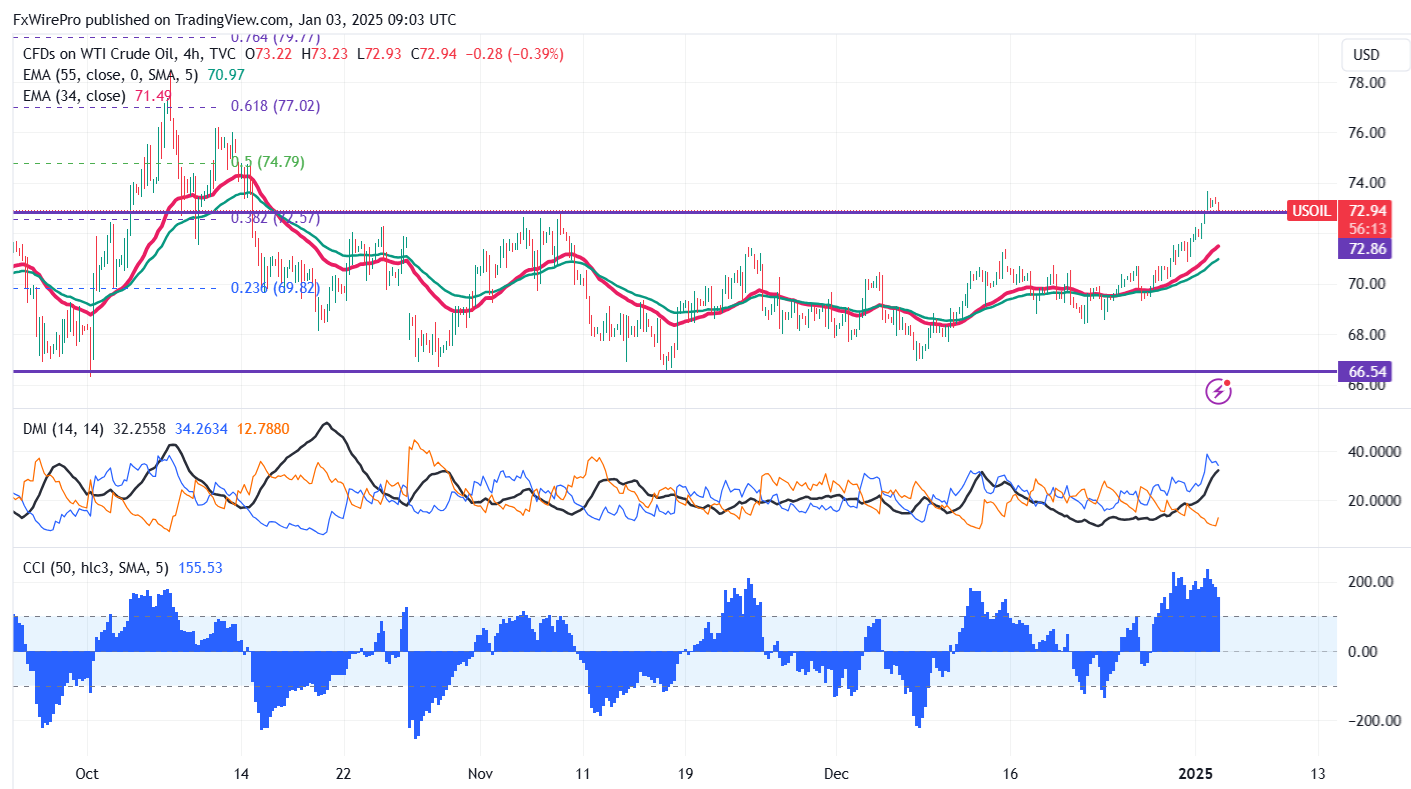Crude oil prices have hit an 11-week high, reaching a peak of $73.69 and currently sitting around $73.02, driven by demand concerns.
U.S. Crude Inventories Decline
Crude oil inventories in the United States fell by 1.442 million barrels in the week ending December 27, 2024. This marks the third consecutive week of decreasing U.S. crude stocks, although the drop was below analysts' estimates. Total crude stocks remain about 5% lower than the five-year average, resting at around 415.6 million barrels. Meanwhile, gasoline stocks increased significantly by 7.7 million barrels, and distillate fuel inventories rose by 6.4 million barrels. This unexpected small drop in crude oil may signal lower demand, potentially leading to reduced prices as consumer behavior shifts toward the end of 2024.
Cold Weather Boosts Crude Oil Demand
Cold weather is likely to increase the usage of crude oil, particularly for heating fuels such as diesel and heating oil. Forecasters have predicted colder temperatures in the United States and Europe, which may lead more people to rely on these fuels to stay warm. This rise in heating needs could boost crude oil consumption during the winter months.
Price Resistance and Support Levels
The near-term resistance for crude oil is around $73.70; breaking this level could push prices higher, possibly reaching $75 or $76. On the downside, immediate support is at $72.50, with any breach below targeting levels of $71.80, $70.75, $70, $69, $68, or even $66.60. It may be advisable to buy on dips around $72.50, with a stop-loss around $71.70 and a target price of $75.



 EUR/JPY Holds Bullish Bias Post-ECB Pause: Buy Dips Toward 185 as 182 Support Stands Firm
EUR/JPY Holds Bullish Bias Post-ECB Pause: Buy Dips Toward 185 as 182 Support Stands Firm  FxWirePro- Major Crypto levels and bias summary
FxWirePro- Major Crypto levels and bias summary  FxWirePro: USD/CAD downtrend slows, but bearish sentiment remains
FxWirePro: USD/CAD downtrend slows, but bearish sentiment remains  FxWirePro: EUR/AUD runs out of steam but maintains bullish outlook
FxWirePro: EUR/AUD runs out of steam but maintains bullish outlook  FxWirePro: AUD/USD struggle to extend its recovery,good to sell on rally
FxWirePro: AUD/USD struggle to extend its recovery,good to sell on rally  FxWirePro: EUR/AUD trends higher, but faces potential pitfalls
FxWirePro: EUR/AUD trends higher, but faces potential pitfalls  FxWirePro: GBP/USD recovers slightly from early decline ahead of Bank of England’s interest rate decision
FxWirePro: GBP/USD recovers slightly from early decline ahead of Bank of England’s interest rate decision  FxWirePro: USD/JPY firms as Japanese Yen weakens after BoJ rate hike
FxWirePro: USD/JPY firms as Japanese Yen weakens after BoJ rate hike  FxWirePro: EUR/NZD steadies ahead of ECB meeting
FxWirePro: EUR/NZD steadies ahead of ECB meeting  FxWirePro: USD/CNY neutral in the near-term, scope for downward resumption
FxWirePro: USD/CNY neutral in the near-term, scope for downward resumption  FxWirePro: GBP/NZD retreats slightly but trend is still bullish
FxWirePro: GBP/NZD retreats slightly but trend is still bullish  FxWirePro- Major Pair levels and bias summary
FxWirePro- Major Pair levels and bias summary  FxWirePro: USD/ZAR bears maintain upper hand
FxWirePro: USD/ZAR bears maintain upper hand  FxWirePro: EUR/NZD uptrend loses steam but outlook still bullish
FxWirePro: EUR/NZD uptrend loses steam but outlook still bullish  FxWirePro- Woodies Pivot(Major)
FxWirePro- Woodies Pivot(Major)  FxWirePro- Major Pair levels and bias summary
FxWirePro- Major Pair levels and bias summary 

























